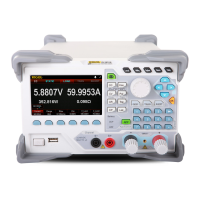Chapter 2 Specifications Test RIGOL
DL3000 Performance Verification Manual
Test Procedures
CR programming accuracy refers to the error between the resistance setting of the
channel and the actual resistance value when the electronic load is in CR mode.
The following section takes DL3031A as an example to test the CR programming
accuracy of the DL3000 series.
Note: During the test, please select the corresponding test record form according to
the model of the DL3000 series under test to set the corresponding parameters,
record and calculate the corresponding specifications.
Specification:
Annual Accuracy
[1]
(25℃ ± 5℃), ± (% of Output + Offset)
Vin/Rset*(0.2%)+0.2%IFS
[2]
Note
[1]
: The accuracy specifications are acquired through calibration at 25℃ after 1-hour warm-up.
Note
[2]
: FS indicates the full scale.
Test Procedures:
1. Power off DL3031A. Connect DL3031A, AC power supply, DC power supply, a
current sampling resistor (with a resistance R
M
0.01 Ω), and a digital multimeter
according to Figure 2-3 (Pay attention to the connection method for the current
sampling resistor, the channel input terminals of DL3031A, and the digital
multimeter). Connect the USB DEVICE interface on the rear panel of the
electronic load to the PC via the USB cable.
2. Turn on the AC power supply, and then set its voltage to 230 V, the frequency to
50 Hz. Then, turn on the output.
Note: The voltage setting of the AC power supply should be matched with the
AC voltage selector on the rear panel of DL3031A.
3. Power on DL3031A, and restores all the settings of the electronic load to its
factory default settings.
4. Turn on the DC power supply, and set its output voltage to 30 V and output
current to 15 A.
5. Measure the CR programming accuracy when the resistance range is a low
range (0.08 Ω to 15 Ω).
(1) Measure the CR programming accuracy when the resistance is set to a low
value.
a) Power on DL3031A. Send the following commands via the remote

